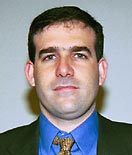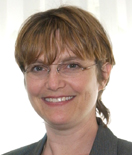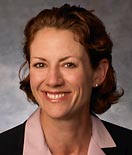UC Berkeley Press Release
Four UC Berkeley faculty honored this week by White House
BERKELEY – The White House honored four researchers from the University of California, Berkeley, this week with awards recognizing their achievements in the fields of science and engineering.
President Bush named Ion Stoica, assistant professor of computer science, Dan M. Stamper-Kurn, assistant professor of physics, and Abby Dernburg, assistant professor in residence in the Department of Molecular and Cell Biology, recipients of the 2002 Presidential Early Career Awards for Scientists and Engineers (PECASE). Dernburg also is a Divisional Fellow in the Life Sciences Division at Lawrence Berkeley National Laboratory.
Stoica, Stamper-Kurn and Dernburg were among 57 scientists and engineers who received the PECASE award, which recognizes the most promising young researchers in the nation.
Lisa Pruitt, professor of mechanical engineering and bioengineering at UC Berkeley, was one of nine individuals to receive the 2003 Presidential Award for Excellence in Science, Mathematics and Engineering Mentoring (PAESMEM). The award recognizes outstanding educational mentoring efforts that foster participation of underrepresented groups - including women, minorities and the disabled - in science, mathematics and engineering.
John H. Marburger III, science advisor to the president and director of the U.S. Office of Science and Technology Policy, presented the PECASE awards Tuesday, May 4, at a White House ceremony. The recipients of the PAESMEM awards were honored at the Eisenhower Executive Office Building in Washington, D.C., on Thursday, May 6.
 Ion Stoica (NSF photo by Patrick Ballou) |
Stoica's research focuses on developing strategies to increase the Internet's efficiency in general communication applications such as video-conferencing, interactive TV and online gaming for mobile users. He is developing an overlay-based Internet Indirection Infrastructure, or i3, that would replace the conventional form of cyber communication that relays packets of data between two hosts.
With the i3 protocol, packets of data would be sent out with an identifier, which receivers would then use to obtain the data. This novel approach addresses the challenges of user mobility, the delivery of information to multiple users, and can protect users and services against denial of service attacks.
"This level of indirection decouples the act of sending from the act of receiving, and allows i3 to synthesize a wide variety of communication applications," said Stoica. "It has the potential to ultimately change the way applications are developed and deployed in the Internet."
 Dan M. Stamper-Kurn (NSF photo by Patrick Ballou) |
Stamper-Kurn works with the coldest materials in the universe - atomic gases cooled to less than one-millionth of a degree above absolute zero. At such low temperatures, these gases exhibit properties quite unlike those seen in room temperature materials. Notably, quantum mechanics strongly dictates properties of these gases, yielding a variety of macroscopic, collective quantum phenomena. For instance, ultracold atomic gases have been observed to make a transition to Bose-Einstein condensates, a gas exhibiting superfluidity -the ability of the fluid to flow without resistance.
Stamper-Kurn plans to use this ultracold atomic material as a resource to study an array of complex, many-particle quantum mechanical systems.
"We apply an array of tools to explore a lot of the same ideas and predictions of condensed matter physics - that is, the physics of stuff - even though we are working with a gas that is a million times less dense than most materials that are studied," he said. "With these tools, we can really manipulate atoms to control their internal structure with exquisite precision, and also control their motion by creating different types of boxes they have to inhabit."
Another project seeks to apply ultracold atoms towards engineering new types of quantum optical devices. He and his colleagues are making progress building tiny optical cavities which confine photons between exquisitely reflective mirrors spaced less than 100 microns apart. One rationale for building such a device is for use as a component of a quantum computer, by which information is processed using the rules of quantum mechanics instead of the conventional computers we use today.
With precise control over the internal behavior and motion of ultracold atoms trapped within the cavity, Stamper-Kurn hopes to control the interaction of a single atom with a single photon of light. This allows atoms to be used as storage places for bits of quantum logic (quantum memory) which can be sent out in the form of single photons (quantum wires), ultimately linking up in a quantum information network.
 Abby Dernburg (NIH photo) |
Dernburg studies meiosis, the cell division process that gives rise to reproductive cells such as eggs and sperm. Problems with the process are extremely common in humans, and can lead to devastating diseases such as Down Syndrome and Kleinfelter Syndrome. Her particular interest is how cells achieve fidelity in the transmission of genetic information, despite the complexity of the process. Meiosis requires that each chromosome in a cell's nucleus must recognize and pair with its unique partner, or "homolog," in preparation for the cell division that will happen later. This pairing process remains very poorly understood, even though it was first described over a century ago.
She probes the genetics of meiosis in the roundworm, Caenorhabditis elegans, identifying mutations that perturb the pairing and segregation of chromosomes and then tracking down the mutated genes to find out what they're supposed to do. In her work, she also employs high-resolution three-dimensional fluorescence imaging to observe the effects of mutations on chromosome pairing and segregation.
"We're trying to understand how the pairing process happens and how it's monitored by individual cells. We have recently learned that meiotic cells have a proofreading mechanism that can somehow detect errors in the pairing process and trigger it to commit suicide," she said.
Both Stoica and Stamper-Kurn are supported by grants from the National Science Foundation's Faculty Early Career Development (CAREER) program. The agency considers the program its most important and prestigious awards for new faculty members who show promise as leaders in their fields of science and engineering. Dernburg is supported by a grant from the National Institutes of Health.
 Lisa Pruitt (NIH photo) |
Pruitt, whose expertise is in the field of biomedical engineering, established a mentoring program that helped students transition from undergraduate to graduate level research. She has also developed outreach programs aimed at high school students, and provided an environment where students can rely upon their peers for support.
The PAESMEM award, which is administered by the National Science Foundation on behalf of the White House, includes a $10,000 grant to provide for continued mentoring work. Eight institutions were also recognized for mentoring.

